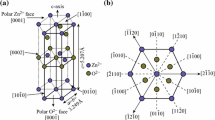Abstract
Electrochemical gold deposition from sulfite solutions was studied by means of voltammetry, EIS and EQCM. A gold film electrode was used for polyaniline layer formation by electrochemical oxidation of aniline. The standard electrochemical reduction potential of the reaction [Au(SO3)2]3− + e− = Au + 2 SO 2−3 was determined, and is equal to 0.116 V (vs. NHE). Both solution stirring and temperature increase accelerate the electrochemical reduction of gold, when the electrode potential is below −0.55 V. When the potential is above −0.55 V the electrochemical reduction proceeds via passive layer formation. Our study suggests that the passive layer consists of chemically adsorbed sulfite ions and sulfur. The gold film deposited from sulfite solution is a high quality substrate suitable for conducting polymer layer formation. This technique, where a polymer layer electrode is prepared by thin gold film deposition onto a metal surface and by subsequent polymer layer formation, can be applied in sensor research and technology.












Similar content being viewed by others
References
Brahim S, Wilson AM, Narinesingh D et al (2003) Microchim Acta 143:123
Sadik OA, Ngundi M, Wanekaya A (2003) Microchim Acta 143:187
Tarasevich MR (1990) The electrochemistry of polymers. Nauka, Moscow
Kaiser H (2002) Edelmetallschichten. Leutze Verlag, Bad Saulgau
Smith PT (1962) US patent No. 3.059.789
Morrissey RJ (1993) Plat Surf Finish 80:75
Dauksher WJ, Resnick DJ, Yanof AW (1994) Microelectron Eng 23:235
Ehrfeld W, Lehr H (1995) Radiat Phys Chem 45:349
Okinaka J, Hoshino M (1998) Gold Bull 31:3
Green TA, Liew MJ, Roy S (2003) J Electrochem Soc 150:C104
Pechewitskij BJ, Erenburg AM (1970) Izv Sib Otdel AN SSSR Ser Khim Nauk 4:24
Wilkinson P (1986) Gold Bull 19:75
Shirai N, Yoshimura S, Sato E (1989) J Surf Finish Soc Jpn 40:543
Honma H, Hagiwara K (1995) J Electrochem Soc 142:81
Honma H, Kagaya Y (1993) J Electrochem Soc 140:L135
Baltrūnas G, Valiūnienė A, Valiūnas R (2003) Pol J Chem 77:1819
Varga K, Baradlai P, Vertes A (1997) Electrochim Acta 42:1143
Fanigliulo A, Bozzini B (2002) Trans Inst Met Finish 80:132
Osaka T, Kato N, Sato J et al (2001) J Electrochem Soc 48:C659
Stoynov ZB, Grafov BM, Savova-Stoinov BS et al (1991) Electrochemical impedance. Nauka, Moscow
Kupper M, Baltrūnas G, Lowe H (1997) Galvanotechnik 88:2906
Baltrūnas G, Drunga V, Švedas D (1994) J Electroanal Chem 365:67
Vetter KJ (1967) Electrochemical kinetics. Academic Press, New York
Grafov BM, Ukshe EA (1973) The electrochemical AC circuits. Nauka, Moscow
Wells AF (1986) Structural inorganic chemistry. Clarendon Press, Oxford
Guiseppielie A, Pradhan SR, Wilson AM et al (1993) Chem Mater 5:1474
Acknowledgments
The authors thank the Lithuanian State Science and Studies Foundation (grant No. B-34/2008) for partial financial support.
Author information
Authors and Affiliations
Corresponding author
Rights and permissions
About this article
Cite this article
Baltrūnas, G., Valiūnienė, A., Vienožinskis, J. et al. Electrochemical gold deposition from sulfite solution: application for subsequent polyaniline layer formation. J Appl Electrochem 38, 1519–1526 (2008). https://doi.org/10.1007/s10800-008-9596-1
Received:
Revised:
Accepted:
Published:
Issue Date:
DOI: https://doi.org/10.1007/s10800-008-9596-1




